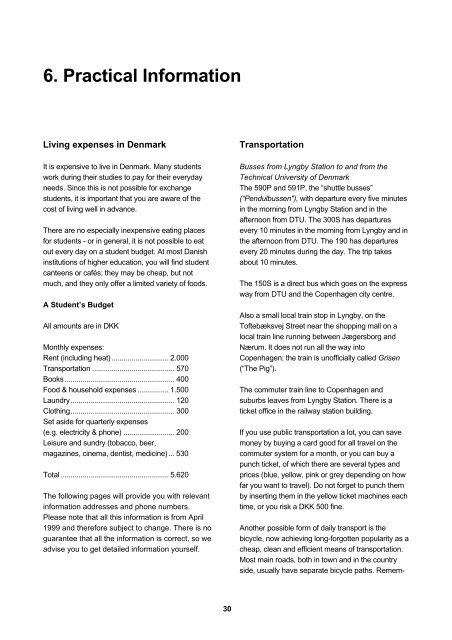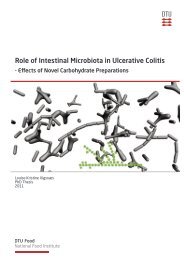2. Welcome to International Affairs - Danmarks Tekniske Universitet
2. Welcome to International Affairs - Danmarks Tekniske Universitet
2. Welcome to International Affairs - Danmarks Tekniske Universitet
You also want an ePaper? Increase the reach of your titles
YUMPU automatically turns print PDFs into web optimized ePapers that Google loves.
6. Practical Information<br />
Living expenses in Denmark<br />
It is expensive <strong>to</strong> live in Denmark. Many students<br />
work during their studies <strong>to</strong> pay for their everyday<br />
needs. Since this is not possible for exchange<br />
students, it is important that you are aware of the<br />
cost of living well in advance.<br />
There are no especially inexpensive eating places<br />
for students - or in general, it is not possible <strong>to</strong> eat<br />
out every day on a student budget. At most Danish<br />
institutions of higher education, you will find student<br />
canteens or cafés; they may be cheap, but not<br />
much, and they only offer a limited variety of foods.<br />
A Student’s Budget<br />
All amounts are in DKK<br />
Monthly expenses:<br />
Rent (including heat) ............................. <strong>2.</strong>000<br />
Transportation .......................................... 570<br />
Books ........................................................ 400<br />
Food & household expenses ................ 1.500<br />
Laundry..................................................... 120<br />
Clothing..................................................... 300<br />
Set aside for quarterly expenses<br />
(e.g. electricity & phone) .......................... 200<br />
Leisure and sundry (<strong>to</strong>bacco, beer,<br />
magazines, cinema, dentist, medicine) ... 530<br />
Total ....................................................... 5.620<br />
The following pages will provide you with relevant<br />
information addresses and phone numbers.<br />
Please note that all this information is from April<br />
1999 and therefore subject <strong>to</strong> change. There is no<br />
guarantee that all the information is correct, so we<br />
advise you <strong>to</strong> get detailed information yourself.<br />
30<br />
Transportation<br />
Busses from Lyngby Station <strong>to</strong> and from the<br />
Technical University of Denmark<br />
The 590P and 591P, the “shuttle busses”<br />
(“Pendulbussen"), with departure every five minutes<br />
in the morning from Lyngby Station and in the<br />
afternoon from DTU. The 300S has departures<br />
every 10 minutes in the morning from Lyngby and in<br />
the afternoon from DTU. The 190 has departures<br />
every 20 minutes during the day. The trip takes<br />
about 10 minutes.<br />
The 150S is a direct bus which goes on the express<br />
way from DTU and the Copenhagen city centre.<br />
Also a small local train s<strong>to</strong>p in Lyngby, on the<br />
Toftebæksvej Street near the shopping mall on a<br />
local train line running between Jægersborg and<br />
Nærum. It does not run all the way in<strong>to</strong><br />
Copenhagen; the train is unofficially called Grisen<br />
(“The Pig”).<br />
The commuter train line <strong>to</strong> Copenhagen and<br />
suburbs leaves from Lyngby Station. There is a<br />
ticket office in the railway station building.<br />
If you use public transportation a lot, you can save<br />
money by buying a card good for all travel on the<br />
commuter system for a month, or you can buy a<br />
punch ticket, of which there are several types and<br />
prices (blue, yellow, pink or grey depending on how<br />
far you want <strong>to</strong> travel). Do not forget <strong>to</strong> punch them<br />
by inserting them in the yellow ticket machines each<br />
time, or you risk a DKK 500 fine.<br />
Another possible form of daily transport is the<br />
bicycle, now achieving long-forgotten popularity as a<br />
cheap, clean and efficient means of transportation.<br />
Most main roads, both in <strong>to</strong>wn and in the country<br />
side, usually have separate bicycle paths. Remem-

















